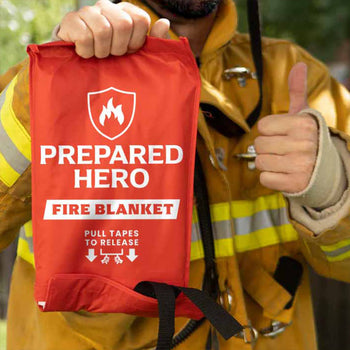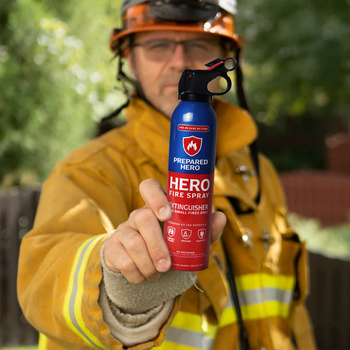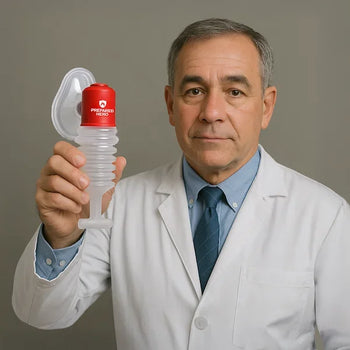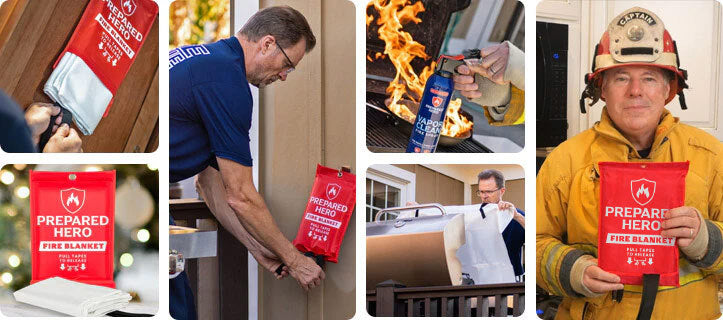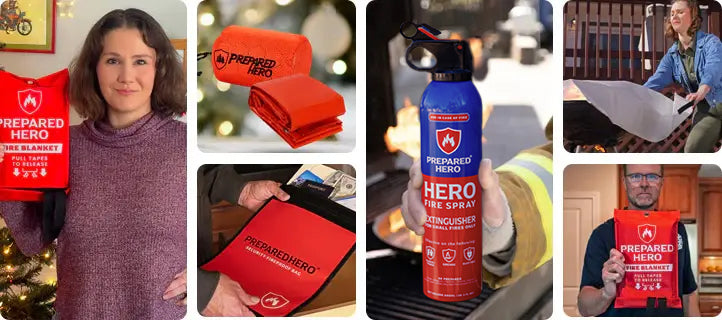Where you put your smoke detectors matters just as much as installing them. Proper placement makes sure they can detect...
According to the US Fire Administration, electrical fires cause an average of 185 deaths, 850 injuries, and $1.5 billion in property loss each year.
The common misconception that any fire extinguisher will do puts you and your loved ones in danger. Knowing the right type of fire extinguisher lets you handle an electrical fire effectively and safely.
Class C fire extinguishers put out electrical fires, which are common in homes, offices, and any other place filled with electrical equipment. But how exactly does it work? What are they made of? How do you use them safely?
In this guide, we’ll talk about Class C fire extinguishers, what they’re used for, what they’re made of, and how to use them. We’ll also cover more affordable and lightweight alternatives that are just as effective.
What Is a Class C Fire Extinguisher?

Class C fire extinguishers are made to put out electrical fires safely. Electrical fires can be difficult to extinguish because they involve delicate equipment that can electrocute you. They’re caused by electrical issues such as:
- Faulty or exposed wiring
- Overloaded outlets
- Malfunctioning appliances
- DIY electrical work
- Overheating
- Poor maintenance
Carbon dioxide, powder, and water mist fire extinguishers can put out Class C fires. Contrary to popular belief, you can use water mist fire extinguishers on electrical fires because they are made of deionized water with extremely small particles. Hence, they won’t electrocute you.
Carbon dioxide fire extinguishers also work well on electrical fires because they’re made of air. As a result, they don’t leave residues that might damage your appliances. In addition, the powder is a poor conductor of electricity, making it an ideal extinguishing agent for Class C fires.
Take note that you should never use water to put out Class C fires. Water is a good conductor of electricity, which puts you at risk of electric shocks. You should also turn off the power source, if possible, before putting out the Class C fire.
What Is a Class C Fire Extinguisher Used For?

Understanding what Class C fire extinguishers lets you handle electrical fires in homes, workplaces, and industrial settings. Here are the most common scenarios where Class C fire extinguishers are needed:
Faulty Wiring
Faulty or exposed wiring is dangerous because it can loosen over time, start a spark, and burn flammable items nearby. If you live in an older house, ask a professional to check your place for faulty wires.
While fires caused by faulty wiring usually start small, they can spread quickly, especially if they’re hidden behind ceilings or walls. You need a Class C extinguisher to prevent this from happening.
Overloaded Outlets
We’ve all been there—plugging too many devices into one outlet or extension cord to charge our phones, tablets, and laptops. A Class C fire can start if that outlet or extension cord overheats. This scenario is common, especially in busy areas like living rooms and offices.
Keeping a Class C extinguisher within reach helps prevent small outlet flames from becoming a full-blown inferno.
Malfunctioning Appliances
We need appliances like ovens, toasters, and space heaters in our daily lives, but they are also fire hazards. They can malfunction over time and lead to Class C fires, and being prepared lets you act quickly.
For instance, your toaster might release smoke while you’re making breakfast. Your space heaters might malfunction and start a fire if placed too close to flammable materials like curtains and furniture. This risk increases during cold months, making heating fires the second leading cause of residential fires, according to the US Fire Administration.
Whether it’s a smoking toaster or a malfunctioning heater, having a Class C extinguisher is your best bet for keeping your home or workplace safe.
Overheating Electronics
We heavily rely on electronics like smartphones, computers, and gaming consoles in this digital age. While they use less electricity compared to appliances, they’re still fire hazards. They can overheat and start a Class C fire, especially in poorly ventilated areas.
Think about this: your computer runs heavy programs and suddenly makes a strange noise and emits smoke. This means it’s overheating and will catch fire soon. Having a Class C fire extinguisher ready lets you act fast and protect your house or office.
DIY Electrical Work
Do-it-yourself (DIY) projects are a great way to improve your home without breaking the bank. But if there’s one thing you can’t DIY, it’s electrical work. You might think that you’re saving money by doing it, but you’re not. Fixing a burned-down house is more expensive, and lives are priceless. Remember, a simple mistake can lead to dangerous electrical fires, and having a Class C fire extinguisher prevents this from happening.
Poor Maintenance
Class C fires are bound to happen when your electrical systems are not checked by a professional. Poor maintenance causes small issues to go unnoticed. This neglect increases the risk of Class C fires. With proper maintenance and a Class C fire extinguisher, you can prevent life-threatening electrical fires and protect your loved ones.
What Is a Class C Fire Extinguisher Made Of?

Class C fire extinguishers are made of different materials, from foam to powder. These extinguishing agents remove at least one element of the fire triangle. Here’s what Class C fire extinguishers are made of:
Carbon Dioxide
Class C fire extinguishers are usually made of carbon dioxide. The main advantage of using carbon dioxide is it doesn’t leave a residue after use. This is particularly useful when dealing with appliances and electronics because the air won’t ruin them.
Class C fire extinguishers work by displacing oxygen, which is an element of the fire triangle. Carbon dioxide is also cold, which helps remove heat from the equation.
Powder
Some Class C fire extinguishers are made of powder with small particulates. They’re usually made of sodium bicarbonate, potassium bicarbonate, or monoammonium phosphate. These chemicals are processed to make sure they flow well and won’t absorb moisture.
Powder fire extinguishers put out fires by spreading and melting over the flames. The powder coats the fuel, creating a barrier between it and the oxygen in the air. As a result, the Class C fire dies down. The powder also protects electronics and appliances against radiated heat, preventing reignition.
Plus, they’re one of the most versatile types because they can put out Class A, B, C, and D fires. You can also use them in places with mixed fire risks. However, you should be careful when using them in tiny rooms, houses, and offices. You might inhale the powder, which can be harmful to your health. But if it’s the only choice you have, please put on a mask before using it.
Water Mist
You shouldn’t use water to put out a Class C fire because it will electrocute you. However, you can use a water mist fire extinguisher to put out an electrical fire.
It’s a more modern tool that doesn’t work like regular water-based fire extinguishers. You see, Class C water mist fire extinguishers are made of deionized water with extremely small particles that don’t conduct electricity. Hence, you can safely use them on electrical fires.
Plus, the water mist doesn’t stream like regular water. As a result, it has better cooling and soaking capabilities. It also helps prevent the electrical fire from spreading more efficiently.
How to Identify Class C Fire Extinguishers
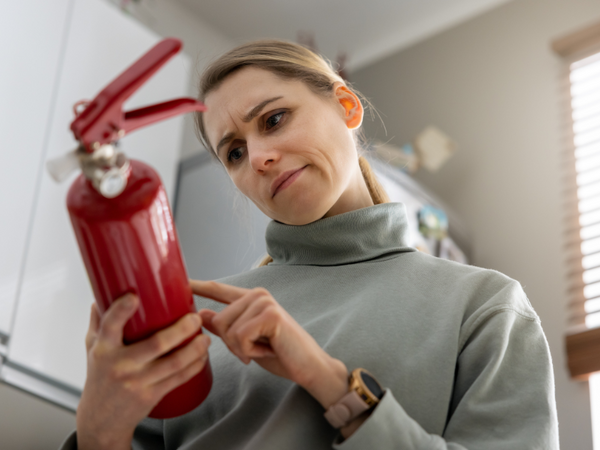
Class C fire extinguishers have a specific symbol: a blue circle with the letter C inside it. The blue circle indicates that the extinguisher can put out electrical fires caused by faulty wiring, overloaded outlets, overheating appliances, and more. If you see a circle with a C, it’s the right extinguisher for an electrical fire.
You can also use multi-purpose extinguishers to put out Class C fires. These fire extinguishers usually show the letters A, B, and C in different shapes. An A inside a triangle means you can also use the extinguisher against fires caused by solid combustibles like wood, paper, rubber, and most plastics. Meanwhile, a B inside a square means you can use the extinguisher to put out flammable liquid and gas fires.
According to the National Fire Protection Association (NFPA), Class C fire extinguishers don't come with numerical ratings. They're only rated for their conductivity. It's either the extinguisher shocks you or it doesn't. To do this, Class C fire extinguishers are tested to see if any electrical current flows through them as they're used on electrical equipment.
How to Use a Class C Fire Extinguisher

Knowing how to use a Class C fire extinguisher helps keep everyone safe, especially if you use a lot of appliances at home or in the office. Class C fires can spread behind ceilings and walls, so learning how to put them out could mean the difference between life and death. You never know when a Class C fire might occur, and having the right knowledge helps you act quickly.
The PASS fire extinguisher protocol stands for Pull, Aim, Squeeze, and Sweep. You should remember this acronym to put out electrical fires properly. Safety experts made this acronym short and direct to the point so people easily remember the four basic steps to using a fire extinguisher. Here’s a more detailed look at the PASS technique:
Pull: Pull the fire extinguisher’s safety pin to unlock the Class C fire extinguisher.
Aim: Aim the hose or nozzle at the base of the fire.
Squeeze: Squeeze the lever or handle to release the extinguishing agent.
Sweep: Sweep the Class C fire extinguisher from side to side until the fire dies.
Please note that PASS is just one part of the equation. You should also know when it’s safe to extinguish the electrical fire. Don’t try to put out the fire if it’s too large or it’s spreading fast, even if you know how to use a Class C fire extinguisher. and call the fire department immediately instead.
How to Maintain Class C Fire Extinguishers

Keeping your Class C fire extinguisher in pristine condition ensures that it’ll work against electrical fires when needed. But how exactly do you maintain a Class C fire extinguisher?
First of all, do regular checks. Inspect your Class C fire extinguisher monthly to see any signs of damage. Is the safety pin in place? Is the pressure gauge in the green zone? Do you need to refill the container? Answering these questions determines if your Class C fire extinguisher needs to be replaced or refilled.
You can also ask a professional to inspect your Class C fire extinguisher at least once every year. They can inspect it thoroughly and make sure everything meets fire safety standards.
Consider hydrostatic testing as well. In general, Class C fire extinguishers need to be tested every five to 12 years. However, stick to specific manufacturer guidelines if they say otherwise.
When to Replace Class C Fire Extinguishers
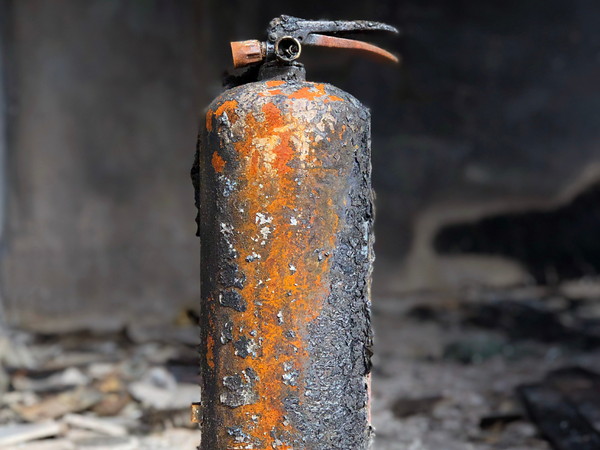
Knowing when to replace your Class C fire extinguisher keeps your loved ones, co-workers, and property safe. Find out when it’s time for a new Class C fire extinguisher below.
1. Your fire extinguisher is expired.
Replace your Class C fire extinguisher if it’s expired. You’ll usually see the expiration date on the container. Even if you haven’t used your Class C fire extinguisher before that date, you should still replace it. It’s also worth noting that expiration dates depend on many factors, including the type of fire extinguisher and how it’s stored. Remember, it’s not safe to use an expired fire extinguisher because it might not work and put everyone at risk.
2. Your fire extinguisher is damaged.
Physical damages can render your Class C fire extinguisher useless. Regularly inspect your fire extinguisher for the following signs of physical damage:
- Dents
- Rust or corrosion
- Cracked hose
- Broken safety pin
- Loose handle or hose
Dents mean that your Class C fire extinguisher container has a weak structure or was mishandled. Meanwhile, a broken safety pin means the extinguisher could set off by itself, leaving you defenseless against an electrical fire.
On the other hand, a loose handle or hose makes it hard to aim the nozzle, release the extinguishing agent, and use the fire extinguisher safely. Rust or corrosion also means critical parts are bound to break, malfunction, or rupture.
3. Your fire extinguisher has low pressure.
A fire extinguisher has a pressure gauge to prevent people from using it when the pressure is low. The right pressure ensures that the extinguishing agent is released with enough force to put out a fire. If the pressure goes low, the extinguishing agent won’t get discharged with the right force or might not spray at all.
4. Regulations or your environment changed.
Safety authorities update fire regulations and standards to keep us safe. Staying up-to-date with these makes sure your Class C fire extinguishers meet the requirements. In addition, the fire hazards around you might change, so you need more Class C fire extinguishers.
For instance, you might need more Class C fire extinguishers if your living room gets bigger or you store flammable liquids and gases in your garage or workshop. Plus, check if your fire extinguisher can put out the types of fire that could break out. If not, replace it.
How Much Are Class C Fire Extinguishers?

Class C fire extinguishers usually cost between $30 and $300. The exact price varies based on the size, brand, and features.
Small, portable, single-use Class C fire extinguishers cost $30 to $80 each. They usually weigh 2.5 to 5 lbs, making them ideal for small spaces. On the other hand, larger Class C fire extinguishers weighing at least 10 lbs usually cost $100 to $300 each. Multi-purpose fire extinguishers are more expensive because they can put out different types of fire.
Class C Fire Extinguisher Alternatives

While Class C fire extinguishers put out electrical fires quickly, they can be expensive, heavy, bulky, and hard to store. They might also contain toxic chemicals and leave residues that are hard to clean up.
The Vapor Clean Fire Spray and Dry Stop Fire Spray are easy-to-use, lightweight, and affordable alternatives to Class C fire extinguishers. These fire sprays are also biodegradable and non-toxic. Unlike a fire extinguisher, you can safely use them around your family and pets.
Here’s a table summarizing the differences between the said fire sprays and a regular Class C fire extinguisher:
|
Vapor Clean and Dry Stop Fire Sprays |
Regular Fire Extinguisher |
|
Lightweight, easy to carry |
Heavy, hard to carry |
|
Affordable |
Expensive |
|
Easy to store |
Needs more space for storage |
|
100% biodegradable |
Mostly made of non-biodegradable materials |
|
Non-toxic |
Toxic |
|
Easy to clean |
Hard to clean |
|
Safe for kids and pets |
Not safe for kids and pets |
Another alternative is a fire blanket, which removes the fire’s oxygen supply. By doing this, it puts out small Class C fires in seconds. It also doesn’t leave a mess because it just covers the fire.
Unlike fire extinguishers, Prepared Hero’s fire blanket doesn’t expire. You can reuse it as many times as you want as long as it’s not damaged. Plus, you can use it to save someone on fire.
Here’s a table summarizing the differences between Prepared Hero’s fire blanket and a regular Class C fire extinguisher:
|
Prepared Hero’s Fire Blanket |
Regular Fire Extinguisher |
|
Lightweight, easy to carry |
Heavy, hard to carry |
|
Affordable |
Expensive |
|
Doesn’t expire |
Expires |
|
Easy to store |
Needs more space for storage |
|
Non-toxic |
Toxic |
|
Doesn’t leave a mess |
Leaves a mess |
|
Safe for kids and pets |
Not safe for kids and pets |
|
Can be used on humans |
Can’t be sprayed on humans |
Do you want reliable, easy-to-use, and affordable tools to put out Class C fires? Check out Prepared Hero’s fire prevention tools here, and get up to 51% off on certain items. Stay prepared, hero!


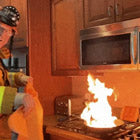 Fire
Fire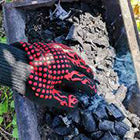 Safety
Safety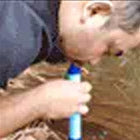 Survival
Survival Protection
Protection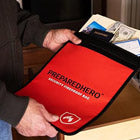 New
New
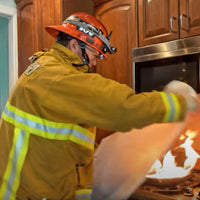 Fire
Fire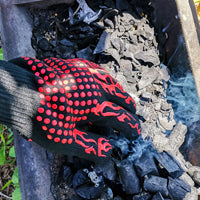 Safety
Safety Survival
Survival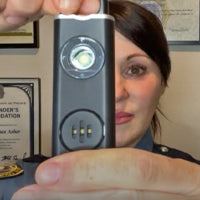 Protection
Protection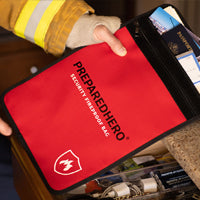 New
New
